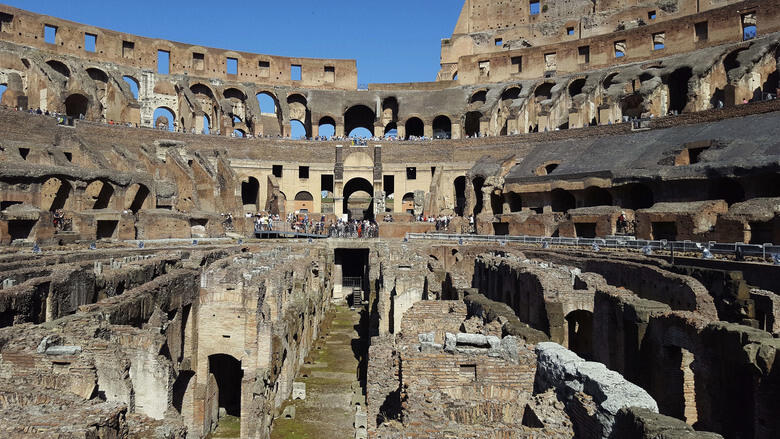The Colosseum has emerged more imposing than ever after its most extensive restoration, a multimillion-dollar cleaning to remove a dreary, undignified patina of soot and grime from the ancient arena, which has been assailed for decades by pollution in traffic-clogged Rome.
Footing the bill is shoe-and-luxury goods maker Tod’s. In an act of modern-day cultural patronage, company founder Diego Della Valle responded to a government call to the private sector to help Italy’s chronically anemic coffers to care for its immense art and archaeological treasures.
And buoyed by the brighter look of the Colosseum’s restoration, which was officially unveiled July 1, Italy’s culture minister, Dario Franceschini, announced that the equivalent of $20 million has been found to replace, by the end of 2018, the arena’s long vanished floor with one that could support modern-day entertainment, although monument-rocking rock concerts have been ruled out.
The stage would be used for “cultural events of the highest level,” Franceschini said.
The first stage of the Colosseum’s restoration consisted essentially of gently removing pollution’s ravages on the exterior of the monument, which dates from the 1st century, with water misters and brushes wielded by hand. The monument stayed open to tourists during the nearly 3-year-long restoration of the outside, with scaffolding covering only one section at a time.
The exterior cleaning cost some $7.2 million. Tod’s is paying more than $27 million for the entire project, whose next steps include constructing a visitors’ center with a cafeteria and shoring up the bottom, where gladiators prepped and wild beasts and scenery were kept for spectacles for the ancient Roman masses.
Della Valle received effusive thanks from Italy’s Premier Matteo Renzi. Companies ranging from Italian fashion houses to a mattress manufacturer to a Japanese textile maker have paid for restorations including the Trevi Fountain, the Spanish Steps and Rome’s own Pyramid.
Franceschini pointed out that the shoe magnate was especially generous, since Della Valle offered the funds before a new Italian law took effect, in late 2014, giving modern-day versions of Medici princes of the arts huge tax breaks. Under that new strategy, more than $112 million has been donated, Franceschini said.
Architect Gisella Capponi, who directed the restoration, says the cleaning allows the Colosseum’s creamy hues of travertine stone to be appreciated again. “The coloration highlights the monument” while the dirt and grime “gave an image of being more a ruin than it really is,” she said.
Indeed, the stone had been so blackened that the Colosseum almost seemed to fade into the background for Romans who passed it daily on their commutes.
But now “the effect is one of surprise,” Colosseum director Rossella Rea said.
The Colosseum has also benefited from a city ordinance forbidding private cars on the nearby boulevard, which flanks Roman and Imperial Forums. Taxis and buses, but not private cars, are allowed on weekdays. On weekends, only pedestrians and cyclists may use the boulevards.
Shopkeepers and other businesses in the area have complained bitterly about the traffic ban but Rea is unrepentant about the need to protect the arena, a UNESCO World Heritage site that is considered Italy’s most famous icon.
“If the heavy traffic, which did the damage, returns, all you’ll need is three, four years to coat the Colosseum again in soot,” she said.
Otherwise, to keep its clean look, all the monument will need in the next years is an annual checkup, with workers going up in cherry-pickers to remove weeds that sprout in the stone’s spaces.
Shoring up the ancient walls and arches of the bottom level could also help fulfill the dream of those who want to see the ancient arena regain new glory as a contemporary entertainment venue.
But first, architects and engineers must determine that 2,000-year-old foundations are sturdy enough to support a new stage. And drainage — which still exploits ancient Roman pipes — must be upgraded and thoroughly cleaned.
A cultural ministry architect, Pia Petrangeli, who oversees sponsorship procedures, says the Colosseum is structurally sound.
“This monument has foundations 15 meters (50 feet)” down, Petrangeli said.
Each year, some 5 million to 6 million tourists traipse through the first two tiers of Italy’s most-visited monument. “It was built to be an arena for shows,” Petrangeli said. “It held many more people than it does today.”
Source: Seattle Times











